Japan's first Super Express
Part 1
TSUBAME during the 1930s
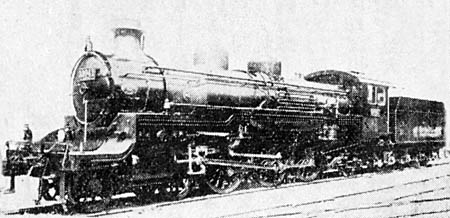
This explanation was written below this photograph :
" The super express test train was a huge success in both directions,
the super express was unique, in that the C51 was of pure Japanese manufacture."
|
|
The Tokaido line is the flagship arterious line which connects Tokyo to Osaka and Kobe(601.2 Kms - during 1930) in Japan.
During 1929, the Ministry of Railways planned a very High-Speed Express, the fastest Limited Express on the Tokaido line.
The background circumstances were mentioned in a magazine, at that time, as follows :
" Presently, the Ministry of Railway's operating distance in kilometers are a total of 14,294 Kms.
It's holds an important position among ground transportation, consequently,
there is always a need for improvement at each facility, and they must meet the demands of the times.
In order to do this, many projects were planned, and in it's first plan, train speed improvement was considered.
These were :
Superexpress service between Tokyo and Kobe would be faster than present Limited Expresses.
An increase in urban neighborhood local expresses,
suburban and local area traffic improvement with raised existing train speed .....
As a part of its improvement, it was implemented in the Osaka area during March of that year (1930).
And the Tokyo area saw an increase on the Nikko, Narita, Chiba and Takasaki line areas from Ueno station.
Originally, our railways had narrow gauge, it was narrower than the European and American broad gauges.
Additionally, there were so many steep slopes and curves on hilly terrain.
Therefore, Euro-American expresses averaged a speed of 96.5 Km/hr which were utterly impossible in Japan.
Currently, the Ltd. Express Fuji, Sakura, and many other expresses are on the Tokaido line.
Of these, even the fastest Ltd. Express, needs a down-train time of 11 hours and 38 minutes,
up-train time is 11 hrs 24 min, between Tokyo and Kobe with station stoppage time.
Their average speed of 53 Km/hr, including station stoppage, still averages 57 Kms/hr ...
this is a deplorable speed. "
........ as said by Ittsei Sakakibara during 1930.
So, the planned High-Speed express was called "A Superexpress " as it was faster than the present Ltd. Expresses.
Fundamentally, two measures were considered as an effective means for speeding up.
They avoided stopping as much as possible, and speed advancements were used for the uphill sections.
The stop stations were confined to six stops for the big cities
......Tokyo, Yokohama, Nagoya, Kyoto, Osaka and Kobe (The engine was replaced only once at Nagoya),
and in addition stops were made one or two times at smaller station operations.
(Down-train ; Kozu and Ogaki, Up-Train ; Numazu)
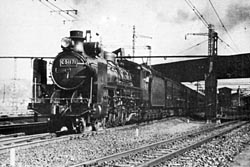
Tsubame leaves Yokohama station
with C51_171. During the 1930s.
(Photo credit to E.Kineya)
|
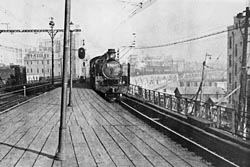
C51_247's down-Tsubame
During 1930s, Shimbashi station.
(Photo credit to E.Kineya)
|
ENGINE
The choice of the engine was limited to either
Class C51 or C53 as they were the fastest engines around at that time.
Their maximum speed was 69 mile/hr.
C53 was a newer design than C51, but C51 was chosen because it was time-proven.
However, a 1930's magazine additionally mentioned that, perhaps, it would be replaced by the C53 in the near future.
And in Tokyo, five C51s were chosen as their superexpress engines.
They were No. C51_171, 208, 239, 247 and 248.
Of these, No.239 was used as the first superexpress to test run.
Later she was preserved at the Umekoji museum in Kyoto. You can see her even now.
These C51s made the 378 kms none-stop long run between Tokyo (Yokohama) and Nagoya.
This was the longest none-stop record in Japanese steam history.
The reason they made such a long run was to reduce engine replacement time.
However, there were problems on such a long run.
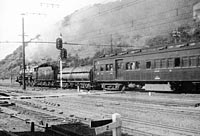
Tsubame running near Kozu yard.
You can see the attached Water-Tank-Car behind C51. During 1931.
|
One was water supply .........
Coal capacity did not have any problems, but water did.
The banking engine attaching for Kozu's stopping time was not enough (30 sec) for water supply.
The water required was 30 tons between Tokyo and Nagoya's 378 Kms at a moderate estimate.
To keep on the safe side, 40 tons was needed.
But, C51's tender had only a 20 ton capacity.
Therefore, at first, JGR planned to make a very long and thin water tank (or ditch) on the side of the railway,
and supply water while the train was running.
However, this plan was canceled because of production costs.
Then, it was decided to make a water capacity 30 ton, special Water-Tank-Car (later called the MIKI-20),
as it was coupled behind a tender.
The Water-Tank-Car had guardrails on the side to prevent injury to the switch crew while running.
The crew change seemed like an action packed movie,
as they jumped from the passenger car to the Water-Tank-Car and finally to the tender and engine.
PASSENGER CARs
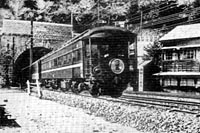
Tsubame entering Tanna tunnel.
The tunnel opened around 1935.
Tsubame has the observation car at its end after Sep 1931.
|
The passenger car formation was kept to a minimum number of seven.
They were from the engine end ;
3rd class seat car with luggage room, Class SuHaNi-31,
3rd class seat car SuHa-32,
3rd class seat car SuHa-32,
Dining car SuShi-28,
2nd class seat car SuRo-32,
2nd class seat car SuRo-34,
1st class sleeping car MaINeFu-29.
Tsubame utilized less cars in order to maintain faster speeds for uphill slope sections.
BANKING ENGINEs
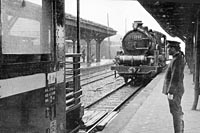
The photograph shows the banking engine D50_268 attaching to the rear of the up-Tsubame.
during 1934. Numazu.
(Photo credit to E.Kineya)
|
Originally the plan was for the banker to attach and detach while the train was moving.
Tests were carried out successfully and crews were trained for a month but in the end the idea was dropped for safety reasons.
As a result it was decided that down-Tsubame would stop at Kozu and Ogaki and up-Tsubame at Numazu, for 30 seconds in each case, for the banker to be attached.
Detachment, however, was still made from the moving train at Gotemba and Kashiwabara in line with the original plan.
D50s were chosen as bankers for the Ltd Exp 'Fuji' and 'Sakura'.
And Numazu depot's C53s (No.81 82 and 84) were used for the 'Tsubame's banker.
Previously, Hakone and Sekigahara pass uphill slope sections driving speed was 30 Km/hr even with Ltd. expresses.
But, superexpress improvment was great, like the max 80 Km/hr between Kozu and Yamakita,
50-60 Km/hr at the 2.5% uphill slope on the Hakone pass, 70 Km/hr on the Sekigahara pass.
|
| |
* * * * * * * * * * * * * * * * * * * * *
|
The superexpress was nicknamed the "Tsubame (Swallow)" during September 1929.
This was the first train nicknamed in Japan along with "Sakura (cherry)" and "Fuji (the famous mountain name)".
Finally, Tsubame's down-train traveling time was 9 hrs,
and its up-train was 8 hrs 55 min between Tokyo and Kobe with station stoppage time included.
This was reduced to 2 hrs 40 min from the other limited expresses.
The first superexpress Tsubame starting date was decided as the 1st of October 1930.
Before the performance, two test runs were made on the 4th of December 1929 and the 3rd of July 1930.
On this second trial run, before entering main line service,
a detailed article in regard to that ride experience was mentioned during August 1930 from the travel magazine "Tabi".
I include this article's translation as next page.
According to the Oct 1930 time table, Tsubame's schedule was :
Down Tsubame Train No.11 time table
| Station | | Time | Engine
| | Tokyo | d. | 09:00 |
| | Yokohama | a. | 09:26 |
| | | d. | 09:27 |
| | Kozu | a. | 10:10 | Banker
Kozu -> Gotenba
| | | d. | 10:10 |
| | Nagoya | a. | 14:29 | Change
| | | d. | 14:34 |
| | Ogaki | d. | 15:12 | Banker
Ogaki -> Kashiwabara
| | Kyoto | a. | 16:41 |
| | | d. | 16:44 |
| | Osaka | a. | 17:20 |
| | | d. | 17:24 |
| | Sannomiya | d. | 17:56 |
| | Kobe | a. | 18:00 |
|
|
Up Tsubame Train No.12 time table
| Station | | Time | Engine
| | Kobe | d. | 12:25 |
| | Sannomiya | d. | 12:29 |
| | Osaka | a. | 12:56 |
| | | d. | 13:00 |
| | Kyoto | a. | 13:36 |
| | | d. | 13:39 |
| | Nagoya | a. | 15:47 | Change
| | | d. | 15:52 |
| | Numaszu | d. | 19:09 | Banker
Numazu -> Gotenba
| | Yokohama | a. | 20:54 |
| | | d. | 20:55 |
| | Tokyo | a. | 21:20 |
|
|
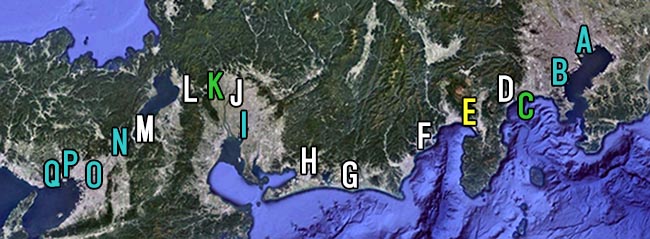
|
Travelling time and average speed (1930)
Station
| Map mark
| | Tokyo | A
| | Yokohama | B
| | Kozu | C
| | Yamakita | D
| | Numazu | E
| | Shizuoka | F
| | Hamamatsu | G
| | Toyohashi | H
| | Nagoya | I
| | Gifu | J
| | Ogaki | K
| | Maibara | L
| | Otsu | M
| | Kyoto | N
| | Osaka | O
| | Sannomiya | P
| Kobe
TOTAL | Q
|
|
Distance
(Kms) | Down-Train
Time
(min) | Down-Train
Average
(Km/hr) | Up-Train
Time
(min) | Up-Train
Average
(Km/hr)
| | 28.7 | 26.0 | 66.2 | 25.5 | 67.5
| | 49.2 | 41.5 | 71.1 | 41.0 | 72.0
| | 16.0 | 15.5 | 62.0 | 13.5 | 71.1
| | 44.3 | 48.0 | 55.4 | 49.5 | 53.7
| | 54.0 | 44.5 | 72.8 | 44.5 | 72.8
| | 76.8 | 64.0 | 72.0 | 64.5 | 71.5
| | 36.6 | 30.5 | 72.0 | 30.0 | 73.2
| | 72.3 | 57.5 | 75.5 | 58.0 | 74.8
| | 30.3 | 26.0 | 69.9 | 24.7 | 73.4
| | 13.8 | 12.0 | 69.0 | 11.7 | 70.5
| | 35.9 | 33.5 | 64.3 | 33.5 | 64.3
| | 57.7 | 46.5 | 74.5 | 46.0 | 75.3
| | 9.9 | 8.5 | 69.9 | 12.0 | 49.5
| | 42.9 | 36.0 | 71.5 | 36.0 | 71.5
| | 31.4 | 27.0 | 69.8 | 27.0 | 69.8
| | 1.6 | 3.0 | 32.0 | 3.0 | 32.0
| | 601.4 | 520 | 69.4 | 520.5 | 69.3
|
|
Blue = Stop station, Green = Down-Tsubame stop and attached banker.
White = Non-stop station, Yellow = Up-Tsubame stop and attached banker.
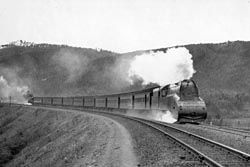
The streamlined C53_43 pulling the up-train Tsubame
in Yamashina near Kyoto during Apr 1936,
with banking engine C11 to the rear of the train.
(Photo credit to K.Nishio)
|
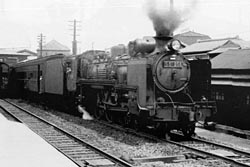
One of the Tsubame engines C51_208,
in her twilight years.
Orio on the Chikuho line during Apr 1959.
(Photo credit to S.Sumino)
|
Superexpress Tsubame was as follows ......
| * | 4 Sep 1931 | Coupled observation car on the tail.
| | * | 25 Dec 1931 |
Irregular extra Tsubame saw service between Tokyo and Osaka.
(Tokyo 09:10 -> Osaka 17:38, Osaka 13:10 -> Tokyo 21:38)
| | * | 15 Mar 1932
| Three minute stopping at Shizuoka for water supply.
Water Tank Car no longer needed.
| | * | 1 Dec 1934 | Tanna tunnel opened. For that reason :
Kozu - Gotenba - Numazu route was changed to Kozu - Atami - Numazu,
therefore, Numazu - Gotenba - Kozu's banker was no longer needed.
Tsubame was reduced by 11.6Kms and 20 minutes.
So, the required time was just 8 hours between Tokyo and Osaka (to Kobe 8 hour 37 min).
This 8 hour record was not broken until Tokaido line electrification on the 19 Nov 1956.
Tsubame's engine was replaced by the electric engine EF53 from C51 between Tokyo and Numazu,
also between Numazu and Kobe C53 took the place of C51.
The up-train between Kyoto and Zeze utilized the banking engine C11.
| | * | 15 Nov 1942 | The irregular extra Tsubame closed its service.
| | * | 24 Dec 1942 | Observation car and a sleeping car service came to an end.
| | * | 1 Oct 1943 | Tsubame service was closed.
|
This page's original title ..... "Superexpress Tsubame" and its history substantially ended on that day.
However, the name Tsubame continued in other successive trains.
| * | May 1950 | Postwar's first Tsubame was started between Tokyo and Osaka,
by the electric engine EF56, EF57 or EF58, and the steam engine C59 or C62.
| | * | Nov 1956 | Tokaido lines all electrification was completed, Tsubame's engine was replaced with electric engines in all sections.
The time required was 7 hours 30 minute between Tokyo and Osaka.
The original pre-WW2 Tsubame's record was broken for the first time.
| | * | May 1960 |
The locomotive train was replaced by the electric car unit (EMU) train.
|
After this Tsubame did not run on the Tokaido line.
They were extraneous trains as "Super Express" trains, they simply took up the name of Tsubame.
| * | Oct 1964 | The service section was moved from Tokaido line between Osaka, Nagoya and Kyushu areas on the Sanyo, Kagoshima lines as the Tokaido-Shinkansen opened.
| | * | Mar 1975 | Sanyo lines Tsubame services were closed as Sanyo-Shinkansen opened.
| | * | Jul 1992 | JR-Kyushu was nicknamed Tsubame between Moji, Hakata and Kagoshima trains.
| | * | Mar 2004 | JR-Kyushu replaced the name of Tsubame to the partly opened Kyushu-Shinkansen trains.
| | * | Mar 2011 |
Kyushu-Shinkansen became available along the entire line. The name of Tsubame was used for the train that stops at every station between Hakata and Kagoshima on the Kyushu-Shinkansen.
|
| |
| |



